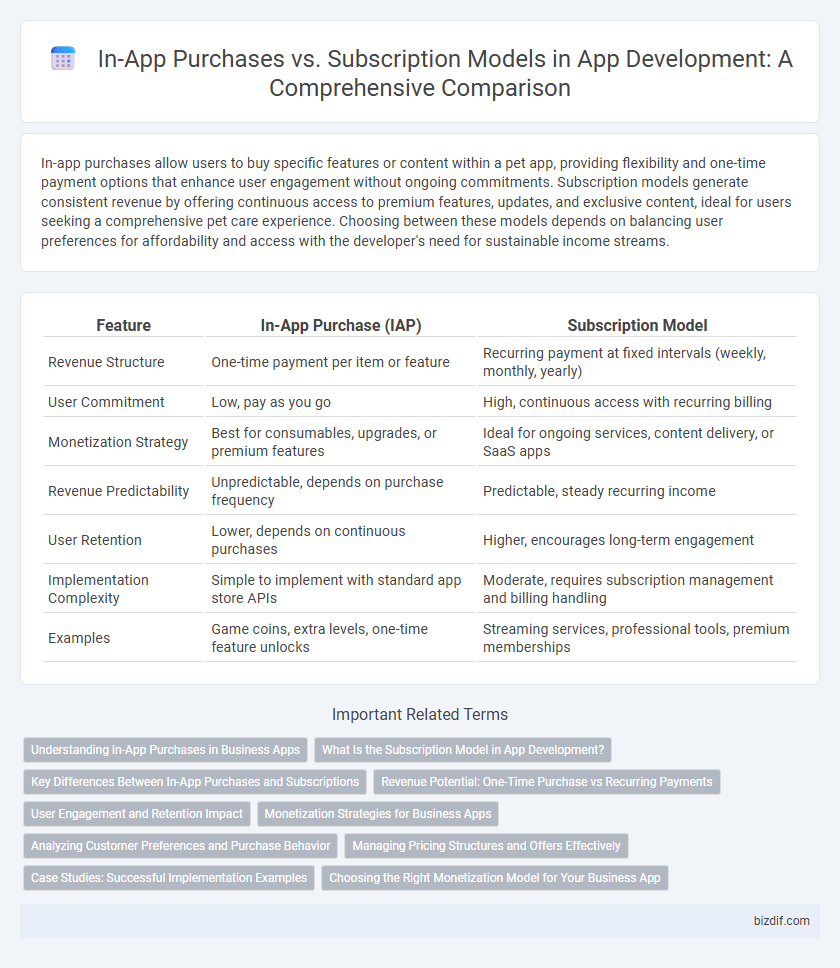In-app purchases allow users to buy specific features or content within a pet app, providing flexibility and one-time payment options that enhance user engagement without ongoing commitments. Subscription models generate consistent revenue by offering continuous access to premium features, updates, and exclusive content, ideal for users seeking a comprehensive pet care experience. Choosing between these models depends on balancing user preferences for affordability and access with the developer's need for sustainable income streams.
Table of Comparison
| Feature | In-App Purchase (IAP) | Subscription Model |
|---|---|---|
| Revenue Structure | One-time payment per item or feature | Recurring payment at fixed intervals (weekly, monthly, yearly) |
| User Commitment | Low, pay as you go | High, continuous access with recurring billing |
| Monetization Strategy | Best for consumables, upgrades, or premium features | Ideal for ongoing services, content delivery, or SaaS apps |
| Revenue Predictability | Unpredictable, depends on purchase frequency | Predictable, steady recurring income |
| User Retention | Lower, depends on continuous purchases | Higher, encourages long-term engagement |
| Implementation Complexity | Simple to implement with standard app store APIs | Moderate, requires subscription management and billing handling |
| Examples | Game coins, extra levels, one-time feature unlocks | Streaming services, professional tools, premium memberships |
Understanding In-App Purchases in Business Apps
In-app purchases in business apps enable users to buy specific features, content, or services directly within the application, offering a flexible revenue stream tailored to user needs. This model supports one-time transactions, allowing businesses to monetize distinct functionalities without requiring long-term commitment from users. Optimizing in-app purchase offerings with clear value propositions enhances user experience and drives higher conversion rates.
What Is the Subscription Model in App Development?
The subscription model in app development allows users to pay a recurring fee, typically monthly or annually, to access premium features, content, or services within an app. This model provides developers with predictable revenue streams and higher customer lifetime value compared to one-time purchases. Popular examples include streaming apps like Netflix and productivity tools like Microsoft 365, which rely on continuous value delivery to retain subscribers.
Key Differences Between In-App Purchases and Subscriptions
In-app purchases allow users to buy one-time digital goods or features within an app, while subscriptions provide ongoing access to content or services for a recurring fee. The payment structure differs significantly: in-app purchases are usually single transactions, whereas subscriptions require continuous billing cycles such as weekly, monthly, or yearly. User retention and revenue predictability are stronger in subscription models due to recurring payments, while in-app purchases often drive immediate, but one-time, monetization.
Revenue Potential: One-Time Purchase vs Recurring Payments
The subscription model generates higher long-term revenue through recurring payments, ensuring a steady cash flow and increased customer lifetime value. In-app purchases provide immediate, one-time revenue but often require constant acquisition of new users to sustain income. Developers must weigh the consistent profitability of subscriptions against the upfront gains of one-time purchases to optimize revenue strategy.
User Engagement and Retention Impact
In-app purchases offer users immediate gratification by allowing one-time transactions for specific features or content, which can boost initial user engagement. Subscription models create a recurring revenue stream by encouraging continuous use, fostering long-term retention through ongoing value delivery. Data shows subscription-based apps often experience higher user lifetime value and regular interaction compared to one-time purchase models.
Monetization Strategies for Business Apps
In-app purchases offer a one-time transaction model ideal for unlocking features or content without ongoing commitment, generating immediate revenue. Subscription models provide steady, recurring income by granting continuous access to premium services or content, enhancing customer retention and lifetime value. Combining both monetization strategies can optimize user experience and maximize profitability for business apps.
Analyzing Customer Preferences and Purchase Behavior
Analyzing customer preferences in app development reveals that in-app purchases appeal to users seeking one-time transactions for specific features or content, while subscription models attract those valuing continuous access and regular updates. Data shows subscription models generate higher lifetime value and consistent revenue, but in-app purchases often lead to higher conversion rates among casual users. Understanding purchase behavior enables developers to tailor monetization strategies, combining both approaches to maximize engagement and profitability.
Managing Pricing Structures and Offers Effectively
Managing pricing structures for in-app purchases requires granular control over individual product pricing, allowing developers to set fixed fees for specific features or content. Subscription models demand dynamic offer management, including tiered plans and promotional trials to maximize user retention and lifetime value. Effective use of analytics and A/B testing tools helps optimize pricing strategies by identifying the most appealing pricing points and discount offers tailored to target audiences.
Case Studies: Successful Implementation Examples
Case studies from leading app developers demonstrate that in-app purchases boost revenue by offering users one-time content or feature unlocks, as seen in gaming apps like Clash of Clans. Subscription models excel in apps like Netflix and Spotify by providing continuous value through regular updates and exclusive content, fostering long-term user retention. Combining both models strategically, as seen in apps like Calm, maximizes monetization by catering to diverse user preferences and engagement patterns.
Choosing the Right Monetization Model for Your Business App
Choosing the right monetization model for your business app depends on your target audience and revenue goals, with in-app purchases offering one-time payments for specific features or content, while subscription models provide recurring revenue through ongoing access. Analyzing user engagement patterns and app usage frequency helps determine whether a pay-per-use approach or continuous access model maximizes lifetime value. Implementing A/B testing and leveraging analytics tools can optimize pricing strategies and improve retention rates across different monetization options.
In-App Purchase vs Subscription Model Infographic

 bizdif.com
bizdif.com